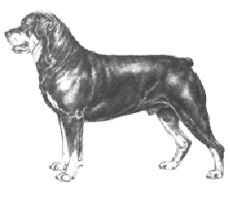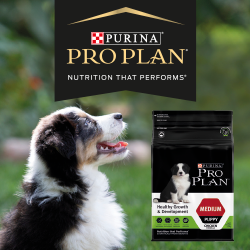Rottweiler
General Information - Rottweiler

Group:
Utility
Size:
large
Lifespan:
10-12 years
Exercise:
medium
Grooming:
very low
Trainability:
medium
Watchdog ability:
very high
Protection ability:
very high
Area of Origin:
Germany
Date of Origin:
ancient times
Other Names:
none
Original Function:
Cattle drover, guardian,
draft
History
The Rottweiler descends from a line of powerful dogs that drove and guarded the cattle of the Roman Army as it traversed Europe. In Rottweil, Germany, this mastiff-type dog was crossed with local herding dogs and was bred specifically as the "butcher's dog of Rottweil." The dog would accompany and guard the butcher on the way to cattle sales, carrying his money en route; he would then drive the purchased beef-on-the-hoof home. An effort was made to conserve the breed when mechanised transport replaced the job of the courageous Rottweiler. This breed requires plenty of room and exercise. He is often nicknamed the "Rottie".Temperament
The Rottweiler is a very territorial, imposing dog breed and is ideal for protection. Headstrong and stubborn, this dog breed requires a strong leader and firm training.Upkeep
The Rottweiler needs daily physical and mental activity, either in the form of long walks or jogs, or a vigorous game in a safe area, as well as obedience lessons. It enjoys cold weather and may become overheated in hot weather. It can live outdoors in temperate to cool climates, as long as plenty of shelter is available. It needs to spend significant time inside with its human family, however, so that proper bonding can occur. Coat care is minimal, consisting only of occasional brushing to remove dead hair.Rottweiler
A breed standard is the guideline which describes the ideal characteristics, temperament, and appearance of a breed and ensures that the breed is fit for function with soundness essential. Breeders and judges should at all times be careful to avoid obvious conditions and exaggerations, as well as being mindful of features which could be detrimental in any way to the health, welfare or soundness of this breed.
Breed Standard - Rottweiler
ORIGIN: Germany.
DATE OF PUBLICATION OF THE ORIGINAL VALID STANDARD: 15.06.2018.
UTILIZATION: Companion, service and working dog.
FCI-CLASSIFICATION: Group 2 Pinscher and Schnauzer type,Molossian type, Swiss Mountain- and Cattle Dogs.
Section 2.1 Molossian type, Mastiff type.
With working trial.
BRIEF HISTORICAL SUMMARY: The Rottweiler is considered to be one of the oldest dog breeds. Its origin goes back to Roman times. These dogs were kept as herder or driving dogs. They marched over the Alps with the Roman legions, protecting the humans and driving their cattle. In the region of Rottweil, these dogs met and mixed with the native dogs in a natural crossing. The main task of the Rottweiler now became the driving and guarding of the herds of cattle and the defence of their masters and their property. This breed acquired its name from the old free city of Rottweil and was known as the « Rottweil butcher’s dog’ ». The butchers bred this type of dog purely for performance and usefulness. In due course, a first rate watch and driving dog evolved which could also be used as a draught dog. When, at the beginning of the twentieth century, various breeds were needed for police service, the Rottweiler was amongst those tested. It soon became evident that the breed was highly suitable for the tasks set by police service and therefore they were officially recognized as police dogs in 1910.
Rottweiler breeders aim at a dog of abundant strength, black coated with clearly defined rich tan markings, whose powerful appearance does not lack nobility and which is exceptionally well suited to being a companion, service, rescue and working dog.
GENERAL APPEARANCE: The Rottweiler is a medium to large size, stalwart dog, neither heavy nor light and neither leggy nor weedy. His correctly proportioned, compact and powerful build leads to the conclusion of great strength, agility and endurance.
IMPORTANT PROPORTIONS: The length of the body, measured from the point of the sternum (breast-bone) to the ischiatic tuberosity, should not exceed the height at the withers by, at most, 15%.
BEHAVIOUR / TEMPERAMENT: The Rottweiler is good- natured, placid in basic disposition, very devoted, obedient, biddable and eager to work. His appearance is natural and rustic, his behaviour self-assured, steady and fearless. He reacts to his surroundings with great alertness and at the same time even- tempered.
HEAD
CRANIAL REGION:
Skull: Of medium length, relatively broad between the ears. Forehead line moderately arched as seen from the side. Occipital bone well developed without being conspicuous.
Stop: Stop relatively strong. Frontal groove not too deep.
FACIAL REGION:
Nose: Well developed, more broad than round with relatively large nostrils, always black.
BRIEF HISTORICAL SUMMARY: The Rottweiler is considered to be one of the oldest dog breeds. Its origin goes back to Roman times. These dogs were kept as herder or driving dogs. They marched over the Alps with the Roman legions, protecting the humans and driving their cattle. In the region of Rottweil, these dogs met and mixed with the native dogs in a natural crossing. The main task of the Rottweiler now became the driving and guarding of the herds of cattle and the defence of their masters and their property. This breed acquired its name from the old free city of Rottweil and was known as the « Rottweil butcher’s dog’ ». The butchers bred this type of dog purely for performance and usefulness. In due course, a first rate watch and driving dog evolved which could also be used as a draught dog. When, at the beginning of the twentieth century, various breeds were needed for police service, the Rottweiler was amongst those tested. It soon became evident that the breed was highly suitable for the tasks set by police service and therefore they were officially recognized as police dogs in 1910.
Rottweiler breeders aim at a dog of abundant strength, black coated with clearly defined rich tan markings, whose powerful appearance does not lack nobility and which is exceptionally well suited to being a companion, service, rescue and working dog.
GENERAL APPEARANCE: The Rottweiler is a medium to large size, stalwart dog, neither heavy nor light and neither leggy nor weedy. His correctly proportioned, compact and powerful build leads to the conclusion of great strength, agility and endurance.
IMPORTANT PROPORTIONS: The length of the body, measured from the point of the sternum (breast-bone) to the ischiatic tuberosity, should not exceed the height at the withers by, at most, 15%.
BEHAVIOUR / TEMPERAMENT: The Rottweiler is good- natured, placid in basic disposition, very devoted, obedient, biddable and eager to work. His appearance is natural and rustic, his behaviour self-assured, steady and fearless. He reacts to his surroundings with great alertness and at the same time even- tempered.
HEAD
CRANIAL REGION:
Skull: Of medium length, relatively broad between the ears. Forehead line moderately arched as seen from the side. Occipital bone well developed without being conspicuous.
Stop: Stop relatively strong. Frontal groove not too deep.
FACIAL REGION:
Nose: Well developed, more broad than round with relatively large nostrils, always black.
Muzzle: The foreface should appear neither elongated nor shortened in relation to the cranial region.
The ratio between the length of the muzzle and the length of the skull is about 1 to 1,5. Straight nasal bridge, broad at base, moderately tapered.
Lips: Black, close fitting, corner of the mouth not visible, gum as dark as possible.
Jaws/Teeth: Upper and lower jaw strong and broad. Strong, complete dentition (42 teeth) with scissor bite, the upper incisors closely overlapping the lower incisors.
Cheeks: Zygomatic arches pronounced.
Eyes: Of medium size, almond-shaped, dark brown in colour. Eyelids close fitting.
Ears: Medium-sized, pendant, triangular, wide apart, set on high. With the ears laid forward close to the head, the skull appears o be broadened.
NECK: Strong, of fair length, well muscled, slightly arched, clean, free from throatiness, without excessive dewlap.
BODY:
Back: Straight, strong, firm. Loins: Short, strong and deep.
Back: Straight, strong, firm. Loins: Short, strong and deep.
Croup: Broad, of medium length, slightly rounded. Neither flat nor falling away.
Chest: Roomy, broad and deep (approximately 50 % of the shoulder height) with well developed forechest and well sprung ribs.
Belly: Flanks not tucked up.
TAIL: In natural condition, strong, level in extension of the upper line; while paying attention, when exited or while moving it can be carried upward in a light curve; at ease may be hanging. While positioned along the leg, the tail reaches approximately to the hocks or is a bit longer.
LIMBS
FOREQUARTERS: Seen from the front, the front legs are straight and not placed too closely to each other. The forearm, seen from the side, stands straight and vertical. The slope of the shoulder blade is about 45 degrees to the horizontal.
LIMBS
FOREQUARTERS: Seen from the front, the front legs are straight and not placed too closely to each other. The forearm, seen from the side, stands straight and vertical. The slope of the shoulder blade is about 45 degrees to the horizontal.
Shoulders: Well laid back.
Upper arm: Close fitting to the body.
Forearm: Strongly developed and muscular. Pasterns: Slightly springy, strong, not steep.
Front feet: Round, tight and well arched; pads hard; nails short, black and strong.
HINDQUARTERS: Seen from behind, legs straight and not too close together. When standing free, obtuse angles are formed between the dog’s upper thigh and the hip bone, the upper thigh and the lower thigh, and the lower thigh and metatarsal.
Upper thigh: Moderately long, broad and strongly muscled. Lower thigh: Long, strongly and broadly muscled, sinewy. Hocks: Sturdy, well angulated hocks; not steep.
Upper thigh: Moderately long, broad and strongly muscled. Lower thigh: Long, strongly and broadly muscled, sinewy. Hocks: Sturdy, well angulated hocks; not steep.
Hindfeet: Slightly longer than the front feet. Toes strong, arched, as tight as front feet.
GAIT: The Rottweiler is a trotting dog. In movement the back remains firm and relatively stable. Movement harmonious, steady, full of energy and unrestricted, with good stride.
SKIN: Skin on the head: overall tight fitting. When the dog is alert, the forehead may be slightly wrinkled.
COAT
HAIR: The coat consists of a top coat and an undercoat. The top coat is of medium length, coarse, dense and flat. The undercoat must not show through the top coat. The hair is a little longer on the hindlegs.
GAIT: The Rottweiler is a trotting dog. In movement the back remains firm and relatively stable. Movement harmonious, steady, full of energy and unrestricted, with good stride.
SKIN: Skin on the head: overall tight fitting. When the dog is alert, the forehead may be slightly wrinkled.
COAT
HAIR: The coat consists of a top coat and an undercoat. The top coat is of medium length, coarse, dense and flat. The undercoat must not show through the top coat. The hair is a little longer on the hindlegs.
COLOUR: Black with clearly defined markings of a rich tan on the cheeks, muzzle, throat, chest and legs, as well as over both eyes and under the base of the tail.
SIZE AND WEIGHT :
Height at withers: For males is 61 - 68 cm.
61 - 62 cm is small 63 - 64 cm medium height. 65 - 66 cm is large - correct height 67 - 68 cm very large.
Weight: 50 kg.
Height at withers: For bitches is 56 - 63 cm.
56 - 57 cm is small 58 - 59 cm medium height. 60 - 61 cm is large - correct height 62 - 63 cm very large.
Weight: Approximately 42 kg.
FAULTS: Any departure from the foregoing points should be considered a fault and the seriousness with which the fault should be regarded should be in exact proportion to its degree and its effect upon the health and welfare of the dog.
• Male animals should have two apparently normal testicles fully descended into the scrotum.
• Only functionally and clinically healthy dogs, with breed typical conformation, should be used for breeding.
SIZE AND WEIGHT :
Height at withers: For males is 61 - 68 cm.
61 - 62 cm is small 63 - 64 cm medium height. 65 - 66 cm is large - correct height 67 - 68 cm very large.
Weight: 50 kg.
Height at withers: For bitches is 56 - 63 cm.
56 - 57 cm is small 58 - 59 cm medium height. 60 - 61 cm is large - correct height 62 - 63 cm very large.
Weight: Approximately 42 kg.
FAULTS: Any departure from the foregoing points should be considered a fault and the seriousness with which the fault should be regarded should be in exact proportion to its degree and its effect upon the health and welfare of the dog.
- General appearance: Light, weedy, leggy appearance. Light in bone and muscle.
- Head: Hound-type head. Narrow, light, too short, long, coarse or excessively molossoid head; excessively broad skull, (lack of stop, too little stop or too strong stop). Very deep frontal groove.
- Foreface: Long, pointed or too short muzzle (any muzzle shorter than 40 percent of the length of the head is too short); split nose; Roman nose (convex nasal bridge) or dish-faced (concave nasal bridge); acquiline nose; pale or spotted nose (butterfly nose).
- Lips: Pendulous, pink or patchy; corner of lips visible.
- Jaws: Narrow lower jaw.
- Bite: Pincer bite. Molars of the underjaw not standing in one line.
- Cheeks: Strongly protruding.
- Eyes: Light, deep set. Also too full and round eyes; loose eyelids.
- Ears: Set on too low or too high, heavy, long, slack or turned backwards. Also flying ears or ears not carried symmetricaly.
- Neck: Too long, thin, lacking muscle. Showing dewlap or throaty.
- Body: Too long, too short or too narrow.
- Back: Too long, weak; sway back or roach back.
- Croup: Too sloping, too short, too flat or too long.
- Chest: Flat-ribbed or barrel-shaped. Too narrow behind.
- Tail: Set on too high or too low.
- Forequarters: Narrow, crooked or not parallel standing front legs. Steep shoulder placement. Loose or out at elbow. Too long, too short or too straight in upper arm. Weak or steep pastern. Splayed feet. Too flat or too arched toes. Deformed toes. Light coloured nails.
- Hindquarters: Flat thighs, hocks too close, cow hocks or barrel hocks. Joints with too little or too much angulation. Dewclaws.
- Skin: Wrinkles on head.
- Coat: Soft, too short or long. Wavy coat; lack of undercoat.
- Colour: Markings of incorrect colour, not clearly defined. Markings which are too spread out.
- General appearance: Too molossoid type and heavy general appearance.
- Skin: Skin at the head strongly wrinkled, strong wrinkles in the area of the forehead, the muzzle and the cheeks, strong dewlap.
- Gait: Sluggish action while trotting.
- Aggressive or overly shy dogs.
- Any dog clearly showing physical or behavioural abnormalities shall be disqualified.
- Behaviour: Anxious, shy, cowardly, gun-shy, vicious, excessively suspicious, nervous animals.
- General appearance: Distinct reversal of sexual type, i.e. feminine dogs or masculine bitches.
- Teeth: Overshot or undershot bite, wry mouth; lack of one incisive tooth, one canine, one premolar or one molar.
- Eyes: Entropion, ectropion, yellow eyes, different coloured eyes.
- Tail: Kink tail, ring-tail, with strong lateral deviation, natural bobtail.
- Hair: Definitely long or wavy coat.
- Colour: Dogs which do not show the typical Rottweiler colouring of black with tan markings. White markings.
• Male animals should have two apparently normal testicles fully descended into the scrotum.
• Only functionally and clinically healthy dogs, with breed typical conformation, should be used for breeding.
DNZ No 672
Copyright Dogs New Zealand
12 Mar 2020
Any departure from the foregoing points should be considered a fault and the seriousness with which the fault should be regarded should be in exact proportion to its degree and its effect upon the health and welfare of the dog and on the dog’s ability to perform its traditional work.



